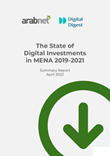
Photo of 3D map of Emirates from Shutterstock
-----
In August 2013, the Central Bank of Lebanon (BDL) surprised the whole entrepreneurship ecosystem, in Lebanon and beyond, with its release of a radical official circular that allocates an unprecedented $400 million to de-risk equity investment in Lebanese incorporated startups. A few months after this announcement, news came out of several funds being raised in the region. Silicon Badia expects to close the Badia Impact Fund of $30 million by the end of this year. Fadi Ghandour, Founder of Aramex and Executive Chairman at Wamda, was quoted in the Wall Street Journal saying that he has launched a new VC fund that aims to close with $75 million, although when we recently asked about the size of the fund, Wamda declined to answer. Middle East Venture Partners (MEVP) announced the launch of their latest fund, the Impact Fund, of $50 million. Berytech Fund is planning to launch its second fund with a target size of $30 million. iMENA Holdings has $30 million ready to be deployed, with a goal to raise that number even higher. And London Mayor Boris Johnson unveiled plans for a $166 million fund to encourage entrepreneurs in the Middle East to go global with their business.

“Two or three years ago, none of these funds would have thought of raising this amount of money,” says Omar Sati, Managing Director at DASH Ventures. “Even though there hasn’t been any exits, like for example Maktoub, I believe the reason they are raising this amount of money today is because they have proved that they know how to deploy this money efficiently. And there are opportunities out there for capital to be placed. There are companies that are doing very well, hiring lots of people, generating healthy revenues, building real products and solving real problems. That is why I believe the big players want to go out to LPs (limited partners) and others and say: we are the right people to raise this money and manage this fund for you,” added Sati.
I believe the reason they are raising this amount of money today is because they have proved that they know how to deploy this money efficiently.
Khaldoon Tabaza, Founder & Managing Director at iMENA Holdings, agrees that the market has potential and “can even support up to $500 million,” but thinks the real problem is deployment.

Raising Funds versus Deploying Money
“Deploying money according to deal flow generated by startups in the market, in my view, doesn’t work well in the MENA region as it does in developed markets such as the US,” says Tabaza. “There might not be that much deal flow that warrants large amounts of capital. In iMENA’s particular case, we are not limited by deal flow that comes to us from the market, but we’re rather proactive, so we build our companies and engage into partnerships and make investments.”
“So many funds have been announced recently,” continues Tabaza, “but it’ll take a significant amount of time for these funds to be deployed.”

Sara Chemmaa from MBC Group concurs with Tabaza. “We believe this money will be used for larger ticket size investments, predominantly on Series B for startups that have proven their business model and were able to show traction. We don’t see many of these stories in the region so far, and we think that it might be challenging for [VCs] to deploy the money.”
Dany Farha, CEO at BECO Capital, dismisses any concerns regarding deployment issues. “We are now making larger investments of more than $3 million per ticket for follow-on rounds for our portfolio’s companies, as well as new investments in Series A stage, which wasn’t the case two years ago,” he says.
Other industry leaders agree with Farha. Walid Hanna, Managing Partner at MEVP, confirms that they are witnessing deal flows of much higher quality than previous years, and Habib Haddad, Founding CEO and General Partner at Wamda, sees the market "maturing, and so is the level of entrepreneurs."

Omar Sati voices their optimism saying: “There’s sufficient deal flow in the region today, and with new funds and capital, more deal flow will spur in the region.” He explains that the lack of deal flow in the past was triggered by the lack of funds, which led many promising entrepreneurs to just turn away and not bother. Now, the story is different. “Instead of talking to 5 potential investors, we can now talk to 10 or 15 investors,” states Sati.
Many people believe there is a deficiency in deal flow because there is a big gap in the evolution of the fund, according to Sati. So far, startups in the region were able to get money at different stages in their lifecycle, up until they need $2 million or $5 million to scale and grow further. “There is absolutely no fund to date in the region that can provide them with this sort of funding,” explains Sati. “This is where the big funds come in to meet this demand,” he adds, and Haddad agrees. They think the real problem was on the supply side (money), and what we are seeing today is simply the supply following the demand.

The Effect of Competitive Funds on Co-Investment
With more funds readily available in the market to meet a limited demand, one might wonder how this will affect the relationship between “suppliers.” Most industry leaders believe that raising bigger funds will have no effect on co-investment. In fact, Farha believes we will see more collaboration and coopetition. “As the deals become larger, they need syndication across trusted partners. Fund sizes are still too small to take on the larger rounds alone,” says Farha.
“We think co-investing is always needed to reduce risk,” says Chemmaa. “We see that each investor brings a different value proposition to the startup, which is by far much more valuable than pure money, and we believe that this will remain.”
Hanna agrees. “Co-invesments will not increase or decrease as these are usually caused by VCs looking at the same transaction and willing to share the risk and double the added value,” he says. Tabaza joins him saying that more co-investment will happen in the future “because of specific added value that those investors are bringing to the table, be it geographic or industry specific, not because of lack of supply or need to add more investors to the round.”
On the contrary, Sati believes co-investment will actually decrease. “These are structured funds with specific criteria, and most important of this criteria is the returns. Many of these funds have to deliver returns for their LPs, and delivering these returns means when you see an opportunity, you will want to optimize your investment. So, rather than co-investing and sharing, you will want to maximize returns instead,” explains Sati. “Now that funds have all this money, there’s going to be no need for them to diversify their financial risks,” he continues. “The number of really attractive startups that pop up a year can be counted on your hand. Funds are going to fight for these opportunities. You’ll still have co-investments; the region is small and there’s a lot of mentality of helping each other, but it will decrease, and funds will become more competitive,” claims Sati.
Will Valuations Be Pressured by Inflation?
Industry leaders seem to have controversial opinion about the effects of bigger funds on inflation. According to Sara Chemmaa, valuations already started to be inflated, but she believes that things will eventually get corrected, and Habib Hadad shares her same view. Walid Hanna sees no escape from inflation, saying: “Increased funds means increased competition, and this will directly drive the valuations upward.”
Omar Sati thinks inflation in valuation is only natural because of the competitiveness of the funds. He expects investors to be willing to pay little bit of a premium to win a deal, but is concerned that inflation might result in “greedy entrepreneurs.” “When you start competing and valuations inflate,” explains Sati, “that’s when I believe entrepreneurs might start asking for much higher valuations than they deserve. When this happens, deals don’t get closed, and the ecosystem gets hurt.”
On the other hand, Dany Farha and Khaldoon Tabaza see no inflationary pressures. “Inflations happen in more mature markets, and I don’t see the driver that would lead to inflation in valuations,” says Tabaza.
What Does All This Mean for the Region?
All players in the ecosystem acknowledge that the big numbers being raised are steps forward towards the “development of the technology economy in our region,” as Farha puts it.

“The increased availability of capital will decrease the risk of failure, since the entrepreneur is well supported financially and monitored by the investors,” says Walid Hanna, Managing Partner at MEVP, who also believes the region will see more exit opportunities and more ventures launched by experienced expats and.
However, Hanna and the others are eyeing the roll out of these funds with caution. Sara Chemmaa emphasizes on the need for the money to be invested carefully at reasonable valuations. “The end aim should be growth and sustainability rather than pure exit, as this is still not an exit market,” she states.
Omar Sati concludes by saying: “All the outcomes of these large funds are a natural evolution of our startup ecosystem. Good things and bad things will come out of them. The important thing is for us to learn from case studies that happened in other markets, like Silicon Valley and Silicon Alley, and make sure we don’t repeat their mistakes.”
Latest Business
Intelligence Report














